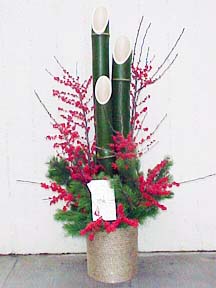
In the Garden![]()
Michael Miyashiro
Kadomatsu
As Christmas comes to a close, another holiday event appears. The ending of one year and the beginning of another is a ritual celebration that many participate in. But many don't fully understand the significance of these celebrations.
The days after the Winter Solstice (Dec. 21) count down the passing to the year's end. In agricultural Japan, the seven days before the year's end and seven days after the new year are celebrated with offerings to the gods to hasten winter and bring on a bountiful harvest year. Many types of offerings are made, but one of the more commonly known traditions is the kadomatsu.
The kadomatsu is primarily composed of bamboo, pine and a fruiting branch. Usually three thick stems of bamboo are cut at a strict slant in different heights, and odd-numbered sets of pine and fruiting stems are tied together, creating a union of good luck. Cutting into a bamboo stem at a strict slant gets the attention of the gods, who take note of this near-impossible task and reward its owner with good wishes for the coming year.
COURTESY RAINFOREST
These three basic elements translate into long life (bamboo), strength (pine) and prosperity (a fruiting branch). Like all things Japanese, this odd-numbered structural balance of pine, bamboo and branch invite the gods that pass over from the old year to the new year to leave their blessings with kadomatsu owners. Having a kadomatsu at your home's entrance appeases the gods and welcomes their goodwill, which is left behind after their passing.
Inside the home are offerings of mochi (rice pounded into a sticky mass), a golden tangerine and a moroba (fern, eucalyptus and bamboo) base. The moroba also has significance in that the fern represents the coming of an early spring, the eucalyptus represents good health, and the bamboo, again, signifies strength.
IN TODAY'S modern world, the kadomatsu represents a gift or gesture to ensure a business will be prosperous and strong. For homeowners, it's a gift of good family health, success, prosperity and happiness. The kadomatsu is the highest form of respect for these qualities and signifies that the sender is sharing his or her own self-worth and wealth wishes with the recipient.
As your kadomatsu ages and dies, it attracts evil spirits to it. Just as firecrackers scare evil spirits away from your home, it is best to burn your kadomatsu on the seventh day of the new year, just in case they have taken up residence in the bamboo. Instead of burning it yourself, you may dump it in with the trash, which will most likely be burned in an incinerator.
It is considered bad luck to keep your kadomatsu longer than necessary. Similar to the principles of feng shui, anything dead in your home is considered bad luck.
Michael Miyashiro, flower connoisseur and graduate of the University of Hawaii horticulture program, is owner of Rainforest at Ward Warehouse. Contact him at 591-9999 or e-mail rainforesthawaii@aol.com. "In the Garden" is a Friday feature.
Gardening Calendar


